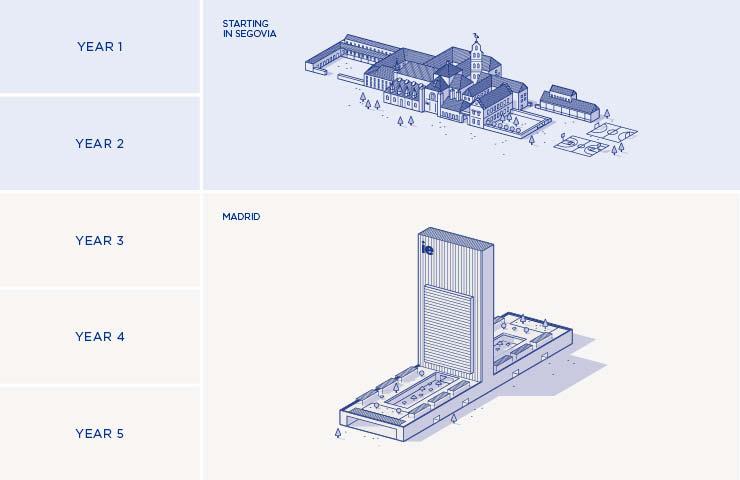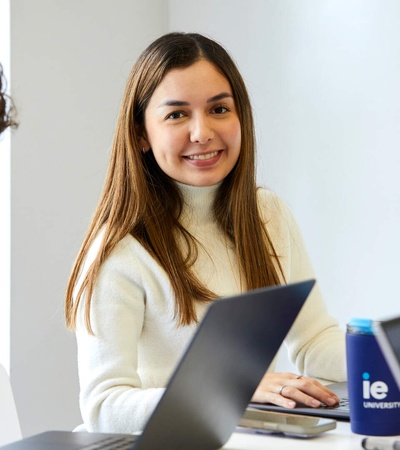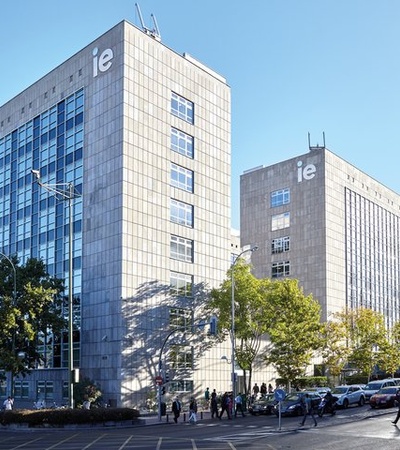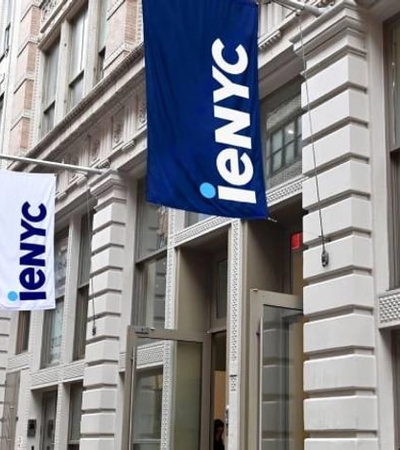Dual Degree in Business Administration & Design
Dual Degree in Business Administration & Design
Boost businesses with design
- Home
- Studies
- Undergraduate Degrees
- Dual Degree In Business Administration & Design
THE Dual Degree in Business Administration & Design
THE Dual Degree in Business Administration & Design
The Dual Degree in Business Administration & Design is a demanding program for creative individuals with a passion for innovation and business, looking to produce lasting value within the corporate world. Embark on a unique learning journey where you harness the power of future-forward design, develop unparalleled business knowledge, and gain real-world, hands-on experience. This one-of-a-kind blended degree has been specially designed to provide a creative, multidisciplinary, and interconnected approach to business administration and design, equipping you with the complete skill set to become a future global leader. You will work closely with IE Business School and IE School of Architecture & Design to integrate core components of design and management as you explore cutting-edge perspectives on traditional business. This will cover key aspects such as how it operates and the role of design in the corporate world.
**Students who complete a Dual Degree at IE University receive two undergraduate diplomas upon graduation. Both programs are fully compliant with the Bologna Process and accredited by the Spanish Government and the European Higher Education Area (EHEA).

WANT TO KNOW MORE?
WHO IS THIS PROGRAM FOR
WHO IS THIS PROGRAM FOR
IS FOR INDIVIDUALS WHO ARE…
creative and analytical, and want to shake up traditional businesses by coming up with human-centered solutions.
LOOKING FOR…
a hands-on program that prepares you to come up with strategic business solutions and practical solutions to complex problems by merging the corporate world with a profound understanding of how products and humans work.
TO BECOME...
- an innovator manager
- a strategy and innovation consultant
- a creative officer
- a user experience designer
- a customer experience researcher
- a business (model) designer
- a brand strategist

location
location
You will study the Dual Degree in Business Administration & Design in Segovia and Madrid. You will spend the first two years at the campus in Segovia, before moving to Madrid for year three, four and five.
FACT SHEET
PROGRAM
Dual Degree in Business Administration & Design
Bachelor in Business Administration & Bachelor in Design
DURATION
5 years
LANGUAGE
English
CENTRES OF STUDY AND NUMBER OF PLACES
Centro de Estudios Superiores IE (Madrid)
Bachelor in Business Administration – 800 places
Bachelor in Design – 60 places
Facultad de Ciencias Humanas, Sociales y de Comunicación (Segovia)
Bachelor in Business Administration – 400 places
Escuela Técnica Superior de Estudios Integrados de Arquitectura (Segovia)
Bachelor in Design – 60 places
CREDITS
Total number of credits: 480 (240 + 240) ECTS*
Distribution of credits and subjects**:
Core subjects – 120 ECTS
Mandatory subjects – 243 ECTS
Elective subjects – 90 ECTS
Final Project – 27 ECTS
AREA OF KNOWLEDGE
Economic Sciences, Business Administration, Marketing, Trade, Accounting and Tourism
Cultural Industries: Design, Animation, Cinematography and Audiovisual Production
TEACHING METHODOLOGY
Face-to-face
DEGREE DATA INTERNAL QUALITY ASSURANCE SYSTEM
SPANISH MINISTRY’S REGISTRY OF UNIVERSITIES, CENTRES AND DEGREES
ASSURANCE AGENCY
ACSUCYL*** – Buscador Títulos Oficiales
*European Credit Transfer System
**The character of the subjects is defined by the Spanish legislation
***Quality Assurance Agency for the University System in Castilla y León
Reasons to study this dual degree
Reasons to study this dual degree
Five reasons to take the Dual Degree in Business Administration & Design at IE University.
- 01.
COMPANIES NEED GREAT DESIGN TO STAND OUT
We live in a constantly evolving and increasingly competitive business landscape. New products and services are unleashed on the market every single minute. In this fast-changing environment, creating new products and services that meet the needs of the people and add value to their life is a challenge. Customer expectations are soaring as global corporations such as Amazon and Google provide innovative digital solutions, blurring the lines between hardware, software and services. For example, both companies' voice-activated assistants—Google Home and Amazon’s Alexa—have integrated users’ real and virtual lives, bridging the gap between hardware and software. Users can now control everything from boiling the kettle to opening their garage doors at the click of a button on their smartphones.
There is a clear link between good design and business success across various industries including consumer goods, retail banking and medical technology. In fact, design is already an integral part of existing businesses—human-machine interactions, AI and engineering psychology are just a few examples. For example, Audi is pioneering a human-powered and self-driving hybrid car, while Dyson’s unique vacuum designs ensure their products stand out for both form and function. Clearly, functionality and good design are crucial to leaving a long-lasting impact on potential customers. - 02.
BRIDGE THE GAP BETWEEN BUSINESSES AND PEOPLE
Nowadays, people expect and demand practical, functional, and convenient products and services. Design is the crucial tool that enables businesses to innovate and disrupt not only products and services, but whole industries, with the aim of improving user experience. Using insights, data, and active listening, you will learn to understand people’s motivations and behavior. You will then be able to personalize products and services accordingly so that they remain valuable. As you create better design strategies to meet people’s needs, you will attract more users and enjoy the added bonus of increased revenue.
Take Netflix as an example. This multinational company is constantly tapping into what the people want, providing an endless range of TV shows and films to satisfy everyone. On top of this, they use data insights to understand their users’ behavior and offer them personalized recommendations. As digital technology advances more rapidly than ever, it is innovation like this that helps businesses to stay one step ahead of their competitors. - 03.
USE DESIGN TO QUANTIFY BUSINESS SUCCESS
Nowadays, designers are occupying more and more space at the planning table. The smartest, most successful companies are combining business management and design experts to create bold and lucrative products and services.
Customer analytics and ROI are two of the most important ways to measure how well a company is performing. However, adopting an analytical approach to design is just as useful for measuring business success. Companies can now incorporate design metrics, such as usability assessments and satisfaction ratings into product specifications. These can then be used to gather highly accurate insights.
Companies can use such insights to track their sales and identify where most of their profit comes from, in turn discerning what aspects of their business bring in the most and least revenue. They can then use this information to work on areas that need improving, saving them time, money, and effort as they know exactly which parts of their company to develop. - 04.
COMBINE THE BUSINESS OF DESIGN AND THE DESIGN OF BUSINESS
Business design represents the middleman between corporate strategy and design thinking, moving beyond aesthetics to evaluate how business and design can complement each other.
By combining design methodologies, a design mindset, and business tools, business design can solve business problems, optimize user experience, and increase revenue. In the words of Steve Jobs, “Design is not just what it looks like and feels like. Design is how it works.” Apple expertly demonstrates this with Apple Pay—a digital wallet service which seamlessly blurs the boundaries between business and digital design by allowing customers to access cash from a device almost everyone carries in their pocket.
Mastering the business behind design, and the design behind business helps to transform business objectives and user needs into meaningful, valuable, and creative solutions. Design strategy involves thinking both analytically and outside the box in order to innovate and implement completely new ideas and processes. Products and services are ultimately improved as a result. Combining business and design strategy therefore helps products and services become better aligned to business goals and customer needs, in turn increasing commercial success. - 05.
ACCELERATE YOUR BUSINESS USING DESIGN
According to software giant Adobe, organizations with a strong design perform 219% better on the Stock Market’s S&P Index over a ten year period than those with poor design. Likewise, the design of a business’ website is crucial for determining that business’ credibility. Therefore, not only does design attract customers, but it also increases trust and convinces them to stay. And with increased loyalty comes an increase in sales and revenue.
Ultimately, fusing good design with great business practices is the key to increasing business efficiency and cost-effectivity, integrating the brand, customer and the product or service.
Dual Degree in Business Administration & Design pillars
Dual Degree in Business Administration & Design pillars
PLACING PEOPLE AT THE HEART OF BUSINESS DECISIONS
It goes without saying that all of an organization’s products and services should be focused on what people need—they are the ultimate driving force behind any business. Research demonstrates that a considerable amount of companies don’t communicate with their end-users when developing a product or service. Additionally, a large majority have no concrete method in place for setting targets with their design teams. If customer insights are neglected, then designers have little to work with. Therefore, if companies truly want to put consumers first, they need to place designers at the heart of their decision making.
DEVELOPING A DESIGN MINDSET
Nowadays, design is a mindset, a way of thinking, a creative process. And the DNA of this process is identifying what the people are searching for. You must first step into their shoes, identify and understand their wants, needs, and expectations. With these insights, you can design, develop, and test a product or service to fill this gap—a solution that both meets and exceeds people’s desires. IE University’s next-level facilities enable you to fully explore your creative side through hands-on, practical learning in our Fab Lab and Design Studio.
This dual degree will encourage you to use both your curious and creative side, and your entrepreneurial and analytical side to drive business success. Combining a design mindset with a developed business acumen will enable you to spot business opportunities, come up with innovative ideas, and ultimately make a long-lasting impact on business results.ADD VALUE TO BUSINESSES AND PEOPLE’S LIVES
Effective design can express and promote a brand’s image and philosophy without the need for words, reassuring customers throughout the whole buying journey. Additionally, on an emotional level, people connect with visual imagery—it draws people towards brands and ultimately boosts customer loyalty. Therefore, a good design results in increased satisfaction and sales, which leads to revenue and business growth. The desire for creative solutions also forces businesses to grow internally, improving operations and efficiency.
As well as this, when applied well, design can completely transform and revolutionize customer experience and add value to people’s lives. Functional products and services can make people’s lives easier in countless ways, so combining future-forward design skills with business acumen will keep you one step ahead of the game.
PUT SOLID BUSINESS AND DESIGN FOUNDATIONS INTO PRACTICE WITH A UNIQUE LEARNING JOURNEY
This one-of-a-kind dual degree seamlessly intertwines business administration and design to provide you with a unique learning journey throughout which you will develop your critical, analytical, and innovative thinking. The course strikes the perfect balance between theoretical and practical knowledge, complemented by real-life case studies to put this acquired expertise into practice. With access to our state-of-the-art facilities, including the Fab Lab and Design Studio, you will be able to put all the knowledge you have acquired throughout the course into practice. These dynamic spaces allow you to roll up your sleeves and use your hands to think, learn, explore, and grow.
Get ready to develop your leadership and managerial skills and enhance your ability to think creatively and produce novel ideas, differentiating yourself as a multidisciplinary individual in a competitive job market and setting you on the right foot to begin a successful and long-lasting professional career.
Undergraduate + Master's Degree Combinations
Undergraduate + Master's Degree Combinations
As an IE University student, you have access to a wide range of opportunities to continue your academic journey and strengthen your global career. Whether you pursue a master’s at IE University or at IENYC in New York, each option is designed to accelerate your personal and professional growth and open doors across industries.
Master’s Degrees & Global Opportunities
Master’s Degrees & Global Opportunities
Explore our partnerships and graduate programs to boost your career and reach your full potential.

Student Stories
Student Stories
At IE University, more than 75% of our student body comes from outside Spain, representing an average of 130 nationalities on campus each year. We take great pride in these numbers—and in the individuals behind them.
Our students are natural go-getters with a global outlook and a dream of a better future. Regardless of their degrees or passions, they strive every day to unleash their innovative potential and reach their goals. Driving this shared vision are people from a variety of cultures, backgrounds and life experiences. They are both united and entirely unique. These are our students. Discover their stories.
GET TO KNOW MORE ABOUT THIS DUAL DEGREE
GET TO KNOW MORE ABOUT THIS DUAL DEGREE
Henry Bradford, Associate Dean of IE Business School, explains in-depth the Dual Degree in Business Administration & Design.

Faculty Stories
Faculty Stories
Our 500-strong faculty guides students to unleash their potential day in, day out. Their influence across all five Schools can’t be overstated, inspiring young, energetic minds as they define their personal and professional trajectories.
But what kind of person does it take to create such impact? The individuals that make up the IE University faculty are special. Coming from diverse, global backgrounds, they each bring distinct perspectives and innovative ideas that embody what makes IE University stand out. Their stories are personal and unique—but don’t take our word for it. Read their stories to see for yourself.
UNSURE IF THIS IS THE RIGHT PROGRAM TO HELP YOU ON YOUR PROFESSIONAL JOURNEY?
UNSURE IF THIS IS THE RIGHT PROGRAM TO HELP YOU ON YOUR PROFESSIONAL JOURNEY?
Discover the Dual Degree in Business Administration & Design related programs:


